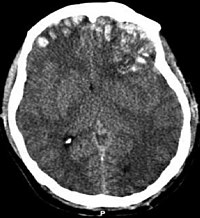
Photo from wikipedia
Purpose Gait evaluation in patients with dizziness is essential during both initial evaluation and vestibular rehabilitation. Inertial measurement unit (IMU)-based gait analysis systems are clinically applicable in patients with dizziness.… Click to show full abstract
Purpose Gait evaluation in patients with dizziness is essential during both initial evaluation and vestibular rehabilitation. Inertial measurement unit (IMU)-based gait analysis systems are clinically applicable in patients with dizziness. Since dizzy patients can utilize visual inputs to compensate for vestibular deficits, it is more difficult for them to walk with their eyes closed (EC). In this study, we compared gait characteristics during forward walking with both eyes open (EO) and EC between healthy subjects and dizzy patients. Materials and Methods Forty-nine healthy controls (mean age 37.18±10.71 years) and 23 patients with dizziness (mean age 49.25±15.16 years) were subjected to vestibular and gait analyses. Medical histories, physical examinations, and vestibular function tests ruled out possible vestibular deficits in the controls. Subjects were instructed to walk at a comfortable pace for 10 m under two conditions (EO or EC). Spatiotemporal parameters, kinematics, and simulated kinetics of each gait recording were recorded using a shoe-type IMU system and analyzed. Results Although gait speeds were slower, stride lengths were smaller, and double support times were increased under the EC, compared to the EO condition, in both healthy subjects and dizzy patients, the difference was more prominent in dizzy patients. Phase coordination index values did not differ significantly in either group. Gait asymmetry (GA) increased significantly under the EC condition, compared to the EO condition, in dizzy patients. Conclusion GA during forward walking was greater in dizzy patients under an EC condition than under an EO condition.
Journal Title: Yonsei Medical Journal
Year Published: 2022
Link to full text (if available)
Share on Social Media: Sign Up to like & get
recommendations!